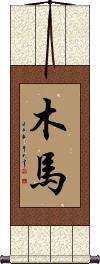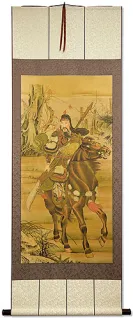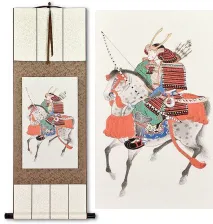Many custom options...
And formats...

Wood Horse in Chinese / Japanese...
Buy a Wood Horse calligraphy wall scroll here!
Wood Horse
The Year of the Wood Horse
This in-stock artwork might be what you are looking for, and ships right away...
Decorative Colorful Abstract Horse Painting
Discounted Blemished
Gallery Price: $90.00
Your Price: $39.00
Gallery Price: $124.00
Your Price: $68.77
Gallery Price: $200.00
Your Price: $79.88
Gallery Price: $108.00
Your Price: $59.88
Gallery Price: $65.00
Your Price: $35.88
Not the results for Wood Horse that you were looking for?
Below are some entries from our dictionary that may match your Wood Horse search...
| Characters If shown, 2nd row is Simp. Chinese |
Pronunciation Romanization |
Simple Dictionary Definition |
木魚 木鱼 see styles |
mù yú mu4 yu2 mu yü mokugyo もくぎょ |
mokugyo; wooden fish (percussion instrument) (Buddhist term) fish gong; fish wood block; temple block; round, hollow, wood block (vaguely fish-shaped, usu. with scales), struck while chanting sutras The wooden fish; there are two kinds, one round for use to keep time in chanting, the other long for calling to meals. The origin of the use of a fish is unkজxample to monks to be watchful: there is no evidence of connection with the Christian ίχθύς.ί 木馬 Wooden horse, a symbol of emancipation. |
甲午 see styles |
jiǎ wǔ jia3 wu3 chia wu kougo / kogo こうご |
thirty-first year A7 of the 60 year cycle, e.g. 1954 or 2014 (See 干支・1) Wood Horse (31st term of the sexagenary cycle, e.g. 1954, 2014, 2074); (given name) Kōgo |
The following table may be helpful for those studying Chinese or Japanese...
| Title | Characters | Romaji (Romanized Japanese) | Various forms of Romanized Chinese | |
| Wood Horse | 木馬 木马 | mù mǎ / mu4 ma3 / mu ma / muma | ||
| In some entries above you will see that characters have different versions above and below a line. In these cases, the characters above the line are Traditional Chinese, while the ones below are Simplified Chinese. | ||||
Successful Chinese Character and Japanese Kanji calligraphy searches within the last few hours...













